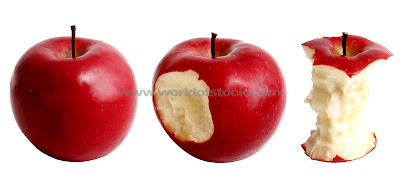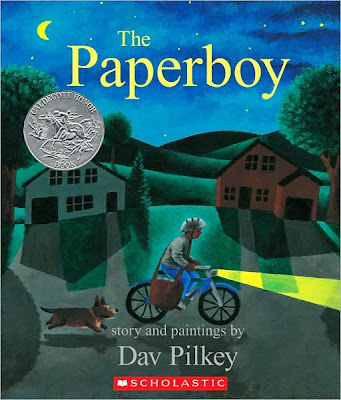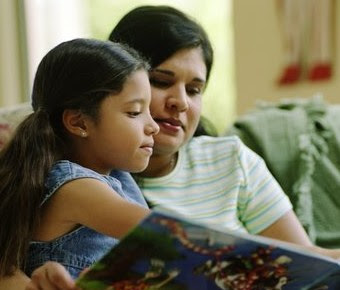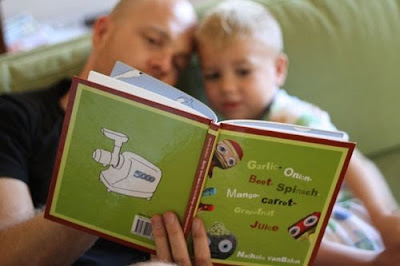

Fortunately, this is easy to teach and there are many, many books out there that lend themselves to this kind of activity very well.
Here's a very short list:
The Lady With the Alligator Purse, by Nadine Bernard Westcott
There Was an Old Lady Who Swallowed a Fly (or a Shell, or a Bat, or any of the bazillion variations on this traditional tale), by VariousGood Night Gorilla, by Peggy Rathman
Rabbit's Pajama Party, by Stuart Murphy
Alexander and the Terrible, Horrible, No Good, Very Bad Day, by Judith Viorst
Manana, Iguana, by Ann Whitford PaulThe Tiny Seed/The Very Lonely Firefly/The Very Quiet Cricket, by Eric Carle
Really almost any book can be used to teach this skill, but when you're dealing with preschoolers it's best to keep things simple. Here's the activity in a nutshell: Read the book, talk about what happened first, what happened in the middle, what happened last or at the end. Boom -- done.
How come none of this looks like chicken nuggets?
For older children, recipes are a good way to practice sequencing. Have your reading child read a recipe as you both prepare it OR find a favorite dish and let your child write out the steps as you cook it. Any activity that has to occur in steps can be good practice for sequencing -- just talking through the steps.
It takes all of about 2 minutes to talk through a story and point out the order of events. Give this one a try next time you read to your little ones.







 Let's get the comic-book and low-brow stuff out of the way first. Ricky Ricotta's Mighty Robot and all its sequels are very much like a comic book without the frames. The pictures are cartoonish, the action is very much the **CRASH!** **POW!** **BAM!** type and the storylines are like a very silly vintage Batman episode. However, the text is just right for beginning readers -- not too much on each page, a little repetitive but not boringly so, amply illustrated so pictures can help with comprehension. These are great books, especially for boys.
Let's get the comic-book and low-brow stuff out of the way first. Ricky Ricotta's Mighty Robot and all its sequels are very much like a comic book without the frames. The pictures are cartoonish, the action is very much the **CRASH!** **POW!** **BAM!** type and the storylines are like a very silly vintage Batman episode. However, the text is just right for beginning readers -- not too much on each page, a little repetitive but not boringly so, amply illustrated so pictures can help with comprehension. These are great books, especially for boys. The low-brow would be the Dumb Bunnies. And before you ask: yes, they are dumb. They may remind you of Amelia Bedelia in that they often take things very very literally, but they have their own loopy charm. They also have some egregious nose-picking, some mild toilet humor, and the weird sight of Papa Bunny strolling everywhere in his tighty-whities. These look like picture books, but are good for Kindergarten/1st Grade kids who can read the fairly simple text and get the textual/visual jokes in the artwork. Kids love the dumb humor, especially the nose-picking.
The low-brow would be the Dumb Bunnies. And before you ask: yes, they are dumb. They may remind you of Amelia Bedelia in that they often take things very very literally, but they have their own loopy charm. They also have some egregious nose-picking, some mild toilet humor, and the weird sight of Papa Bunny strolling everywhere in his tighty-whities. These look like picture books, but are good for Kindergarten/1st Grade kids who can read the fairly simple text and get the textual/visual jokes in the artwork. Kids love the dumb humor, especially the nose-picking.
 One of my favorites is Pilkey's Dragon series -- a very nice set of books that are at an early reader level but very colorfully illustrated. Again, they're like comics without the frames. The character of Dragon is childlike -- sometimes impulsive in a negative way (like when he makes a Christmas wreath of candy and then eats all of it) and sometimes in a positive way (like when he rescues a cat stuck in the snow and ends up adopting it). He's very sweet and likable. These are often available at Scholastic Warehouse sales if you keep your eyes open.
One of my favorites is Pilkey's Dragon series -- a very nice set of books that are at an early reader level but very colorfully illustrated. Again, they're like comics without the frames. The character of Dragon is childlike -- sometimes impulsive in a negative way (like when he makes a Christmas wreath of candy and then eats all of it) and sometimes in a positive way (like when he rescues a cat stuck in the snow and ends up adopting it). He's very sweet and likable. These are often available at Scholastic Warehouse sales if you keep your eyes open.

 Last, there are a few lesser-known Pilkey books, like God Bless the Gargoyles, When Cats Dream and The Moonglow Roll-O-Rama. These are picture books for 4-8 year olds which certainly might be worth a look at your library.
Last, there are a few lesser-known Pilkey books, like God Bless the Gargoyles, When Cats Dream and The Moonglow Roll-O-Rama. These are picture books for 4-8 year olds which certainly might be worth a look at your library. Remember on Monday when I said it's tough sometimes to carve out those 20 minutes for reading practice?
Remember on Monday when I said it's tough sometimes to carve out those 20 minutes for reading practice?






 One of those chunks has to be devoted to reading.
One of those chunks has to be devoted to reading. And yes, you have to make room for it even if the best time to do it is while you're making dinner or right about when you want to put your own feet up and just be for a little while, or you've just gotten home from work and all you can think about is what the score might be in the game you were listening to on sports radio on the way home, or when you've spent most of the day running people to and from here and there and THEY don't want to read to YOU and you have to make them although secretly you'd rather just go take a long hot bath but the teacher says they have to read to you.
And yes, you have to make room for it even if the best time to do it is while you're making dinner or right about when you want to put your own feet up and just be for a little while, or you've just gotten home from work and all you can think about is what the score might be in the game you were listening to on sports radio on the way home, or when you've spent most of the day running people to and from here and there and THEY don't want to read to YOU and you have to make them although secretly you'd rather just go take a long hot bath but the teacher says they have to read to you.